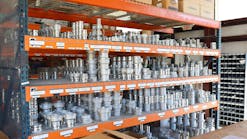Platform Science, Navistar add Virtual Vehicle solution to International trucks
LAS VEGAS—Navistar will begin integrating Platform Science’s Virtual Vehicle, an open OEM platform for fleets, into its International Truck models in 2023, the two companies announced March 21. Navistar’s expansion of its OnCommand Connection telematics hardware to all its International trucks, announced earlier this month, will open the way for the Virtual Vehicle system.
The Virtual Vehicle gives fleets access to telematics, software solutions, real-time vehicle data, and third-party applications directly from their vehicles. The collaboration with Navistar will provide International Truck customers with access to a customizable platform that opens up new capabilities to innovate and utilize, manage and deploy digital applications, company executives said during the opening day of the Truckload Carrier Association’s Truckload 2022 convention and exhibition here.
Darrin Demchuk, Platform Science's VP of fleet solutions, compared the Virtual Vehicle to the Android operating system, which is available on smartphones made by many different manufacturers “who conform their hardware platforms to the software platform. Then app developers build to the software platform,” he said. “So we’re taking that same analogy and applying it to particular commercial vehicles. The benefit of that is fleets can start to make software-only decisions as opposed to software and hardware decisions.”
Daimler Truck North America, which invested in Platform Science late last decade, plans to also integrate the Virtual Vehicle into its Freightliner and Western Star trucks, it announced last November.
Beginning in 2023, the International factory-installed Virtual Vehicle system would allow fleets to create software experiences for their specific business needs. Platform Science said its platform allows developers to create more applications for drivers and fleets. Virtual Vehicle uses edge, cloud, and in-dash data to optimize networks, keeping data available around the clock.
“Navistar’s integration of Virtual Vehicle allows us to leverage a combined solution to look at efficiencies in how we conduct maintenance today,” said Tony Wahl, director of equipment purchasing for Werner Enterprises. “This level of connectivity between service providers simplifies the maintenance process and helps us operate more effectively.”
Sean Slyman, Navistar’s director of connected services, said that customers such as Werner are seeking these solutions. “They don’t want to buy additional pieces of hardware,” he said. “As an OEM, we have the best access and best understanding of the data coming off the vehicle with everything that’s going on the vehicle CAN-bus. And because there are lots of different telematics providers, that means there’s a variance of data quality. So we have a consistent and single source of data coming from a vehicle. From a customer standpoint, coupled with the Virtual Vehicle solution, it gives them—the customers—consistent access to data.”
All that data doesn’t mean much unless fleets know what to do with it. And Navistar wants to help fleets prevent “analysis paralysis,” Slyman said. For large fleets, going each vehicle’s data would be futile, he explained. “So what we do is sort through that data and tell fleets to focus on trends that we’re seeing. We can tell them, ‘These are the drivers you want to focus on. These are the maintenance issues you want to focus on. Because we give that level of insight.”










